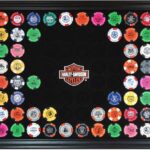I. Understanding Copyright and Upcycled Items
II. Legal Implications of Using Copyrighted Logos in Upcycling
III. Alternatives to Selling Items with Copyrighted Logos
Understanding Copyright and Upcycled Items
Hey there, fellow creative minds! If you’re into upcycling, you’re probably familiar with the joy of transforming old items into something fresh and fabulous. But before you dive headfirst into your next project, it’s essential to grasp the basics of copyright—especially when it comes to using logos and designs. Let’s chat about what copyright really means in the world of upcycled items and how it can affect your creative endeavors.
What is Copyright?
First things first: copyright is a legal term that protects original works of authorship. This includes everything from music and literature to art and design. When you create something original, you automatically have copyright over it, which means you control how it’s used and distributed.
Now, you might be wondering, “What does this have to do with upcycling?” Well, when we upcycle, we often incorporate various elements from different sources, including logos, brand designs, and other copyrighted materials. This is where things can get a bit tricky!
Copyright in the Context of Upcycling
When you come across a cute logo on an old t-shirt or a charming design on a vintage mug, it’s easy to think, “What a great idea for my next project!” But remember, just because something is old or discarded doesn’t mean it’s free to use. Here are a few things to keep in mind:
- Ownership: Copyright doesn’t expire just because an item is no longer being produced. For example, a logo from a popular brand still belongs to that company, even if the item itself is decades old.
- Derivative Works: If you alter or transform an item that has copyrighted material, it’s still possible to infringe on the original copyright if the essence of the original work remains recognizable.
- Commercial Use: Selling your upcycled items can complicate things even more. Using copyrighted logos in items you plan to sell can lead to legal issues, as it’s considered commercial use of someone else’s intellectual property.
Why Understanding Copyright is Important
So why bother with all this copyright talk? Well, understanding the implications can help you:
- Avoid Legal Trouble: No one wants to face a cease-and-desist letter or worse, a lawsuit. Familiarizing yourself with copyright laws helps you steer clear of these potential pitfalls.
- Be Creative Within Boundaries: Knowing what you can and can’t do inspires innovative thinking. You’ll learn to explore new ideas and designs that don’t infringe on others’ rights.
- Build Your Brand: If you aim to sell your pieces, creating and promoting your designs will help establish a unique brand identity, setting you apart from the crowd without the risk that comes with using copyrighted materials.
In conclusion, while upcycling is a fantastic way to express your creativity and promote sustainability, it’s crucial to navigate the waters of copyright law effectively. By understanding the basics, you’ll be better equipped to create stunning pieces that are uniquely yours. Happy upcycling!
Legal Implications of Using Copyrighted Logos in Upcycling
So, you’re diving into the world of upcycling, and your creative juices are flowing. You’ve got some fabulous ideas to turn everyday items into unique treasures. But wait—before you grab that old t-shirt with a cool logo or a vintage coffee mug adorned with a popular brand, let’s chat about copyright laws and what they mean for your upcycling projects.
What is Copyright?
First off, copyright is a form of protection given to the creators of original works. This includes everything from books and songs to logos and graphic designs. When a logo is copyrighted, the owner has exclusive rights to use it, and using it without permission can lead to some serious legal trouble.
Why You Should Be Careful
Using copyrighted logos in your upcycled creations might seem harmless—after all, you’re giving new life to something that would otherwise be tossed aside, right? But here’s the catch: if you sell items featuring these logos, you could be stepping into murky legal waters. Here’s why you should tread carefully:
- Potential Lawsuits: Copyright infringement can lead to lawsuits from the logo’s owner. Even if you didn’t think you were harming anyone, the law is quite clear, and they might not see it your way.
- Fines and Damages: If found guilty of copyright infringement, you could be liable for hefty fines or even damages, which can seriously cut into your profits.
- Cease and Desist Letters: Many companies vigorously protect their trademarks and copyrights. You could receive a cease and desist letter, which is a formal request to stop using their logo. This can create unnecessary stress and disrupt your business.
Fair Use: A Gray Area
You might have heard of “fair use” and wondered if it applies to your upcycled goods. Fair use is a legal doctrine that allows limited use of copyrighted material without permission. However, it’s often a gray area and can be tricky to navigate. Some factors to consider include:
- Purpose of Use: Are you using it for commercial purposes? Generally, fair use is more likely to apply to educational or non-profit contexts.
- Amount Used: Using a small portion of a logo might be considered fair use, but this isn’t a guarantee, especially when it comes to brand logos.
- Effect on Market Value: If your use of the logo could harm the original creator’s market, it’s less likely to be considered fair use.
What Can You Do Instead?
If all this sounds a bit overwhelming, don’t fret! There are plenty of ways to create and sell upcycled items without stepping on copyright toes. Here are some ideas:
- Create Original Designs: Instead of using existing logos, why not design your own? This way, you can let your creativity shine without worrying about legal issues!
- Use Generic or Public Domain Images: There are many resources online where you can find images that are free to use. Look for public domain or Creative Commons-licensed works.
- Collaborate with Artists: If you have a friend who’s an artist, consider collaborating! They can create unique artwork for your upcycled pieces, ensuring everything is original.
In conclusion, while upcycling is a wonderful way to be creative and sustainable, it’s essential to stay aware of copyright implications. By understanding the legal landscape, you can keep your creative endeavors fun and stress-free. Happy upcycling!
Alternatives to Selling Items with Copyrighted Logos
So, you’ve discovered the world of upcycling and are excited about turning old items into something fabulous, but wait—what about those pesky copyrighted logos? Don’t worry! There are plenty of creative avenues to explore that don’t involve any legal headaches. Let’s dive into some fun and innovative alternatives!
1. Embrace Your Creativity
Instead of using copyrighted logos, why not channel your inner artist? You can personalize your upcycled items with your own original designs. Here are some ways to express your creativity:
- Hand-Painting: Grab some fabric paint or acrylics and start painting your own patterns or images. Whether it’s a floral motif or geometric shapes, the sky’s the limit!
- Stencils: Create or purchase stencils that reflect your style. Stenciling can add a professional touch and keep your work unique.
- Decoupage: Use magazine cutouts, old books, or even scrap fabric to decorate your items. This technique allows for endless customization and can give new life to any piece.
2. Go for Upcycled Materials
While you’re upcycling, consider using materials that are not only fun but also sustainable. Here are some ideas:
- Vintage Fabrics: Search for unique fabrics at thrift stores or flea markets. Vintage patterns can add character to any upcycled item.
- Natural Materials: Explore using wood, stones, or even reclaimed metal. These materials can give your pieces a rustic or modern vibe, depending on your style.
- Old Jewelry: Repurpose broken jewelry into embellishments for your projects. This can add a touch of elegance and history to your creations.
3. Craft Functional and Artful Items
Think outside the box! Instead of reproducing items that could infringe copyright, create functional and artful pieces that use your innovative designs. Some ideas include:
- Home Decor: Transform old furniture or household items into stunning decor pieces, like a coffee table made from reclaimed wood or a lamp created from vintage items.
- Fashion Accessories: Turn discarded clothing into trendy bags, hats, or jewelry. Upcycling clothing not only saves resources but also creates one-of-a-kind fashion statements.
- Garden Art: Use old metal cans or glass bottles to create planters or garden decorations. Your garden can become a showcase of your creativity!
4. Collaborate with Local Artists
Networking with local artists can spark inspiration and lead to exciting collaborations. Consider:
- Workshops: Join classes or workshops where you can learn new techniques and share ideas.
- Community Events: Participate in local craft fairs or markets to showcase your unique creations without infringing on anyone’s copyright.
5. Educate Your Audience
Finally, don’t shy away from sharing your process and the importance of copyright awareness with your audience. Create engaging content that informs others about:
- The value of original art and designs.
- The joys of upcycling and sustainability.
- How to respect and understand copyright laws while being creative.
In the end, upcycling is about creativity and sustainability. By steering clear of copyrighted logos, you can create something truly unique that showcases your artistry while avoiding any legal bumps along the way!










Comments